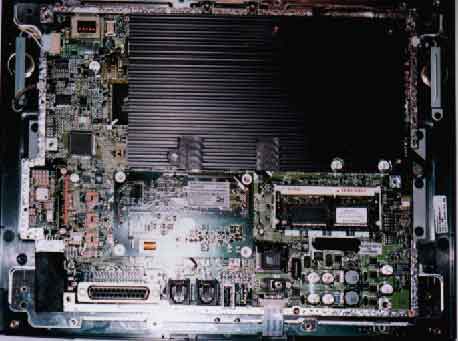Netpliance's Modified i-opener
|
Features
|
The
Board
|
- 32 MB memory
with 16 MB flash memory
- 200 MHz Winchip
processor
- 9.33" x 11.96"
x 3.5" · Weight: 5.08 lbs.
- 10" LCD screen
(800 x 600 resolution)
- 56k call waiting
modem
- On board video
and sound
- Shortcut keys
on the keyboard
- Printer and USB
connectors on the rear
|
|
When I reviewed the i-opener
a couple of things became obvious about the unit. First, for $99 you could
get a pretty capable computer. This is not a machine that you would want to
game on but could cover the basics necessary for most web browsing and word
processing. Second, the operating system shipped with the unit left a lot
to be desired. For those who are still wondering why anyone would bother to
modify an i-opener should consider that for $99 you get:
These aren't the specs
I would pick for a Quake III server, but it more than gets you by for a basic
machine that can be portable due to its small size. I needed a replacement
for my aging laptop. I had priced installing a larger HD into the laptop and
adding more memory but that alone cost nearly what it cost to modify the i-opener
(including the price of the i-opener). I still wouldn't have had USB or the
built in 56k modem so it didn't take me long to realize I could sacrifice
a floppy and CD-ROM in order to get more CPU power. To move files to and from
the i-opener I simply needed to connect it to my network.
Let's get started
If you have access to
an i-opener that is out of its internet service contract you can follow the
steps I outline here to modify your unit. I wouldn't recommend someone who
is not familiar with OS installation or hardware trouble shooting try this
because of the amount of problems that can pop up. The i-opener is a unique
piece of hardware: part laptop design and part desktop design. If you are
comfortable doing normal hardware upgrades you should be able to upgrade your
unit without too much difficulty. I hope you realize I'm not responsible for
any damage or loss of function of your unit if you attempt this, and obviously
you will void your warranty by opening the case. Hate to throw in the legal
bomb there but I'm sure I would get an e-mail from somebody if I didn't.
 The
first thing you should determine is if you have a unit that was shipped with
the modifications that were supposed to thwart hackers. The original units
are the easiest to modify, but this won't stop you from modifying one of the
newer versions. On the rear of the unit it the small access door that allows
you to upgrade the memory. While looking into this area you can look to the
left of the memory and find the BIOS chip. If the chip has epoxy on it then
you have one of
The
first thing you should determine is if you have a unit that was shipped with
the modifications that were supposed to thwart hackers. The original units
are the easiest to modify, but this won't stop you from modifying one of the
newer versions. On the rear of the unit it the small access door that allows
you to upgrade the memory. While looking into this area you can look to the
left of the memory and find the BIOS chip. If the chip has epoxy on it then
you have one of
the "modded" units from
the factory. The picture to the right is hard to see but the BIOS chip is
just below and to the left edge of the memory. That black stuff covering two
corners and sides is the epoxy. You need to know which version of the I-opener
you have because one of the changes made to the unit was a BIOS change. The
BIOS chip is flashable, so you merely have to obtain the correct BIOS. This
can be done through a web search or simply use an original BIOS equipped machine
as the BIOS donor. I won't go into high detail about BIOS flashing, especially
considering there is no floppy drive to make this easier. I recommend that
you get a replacement chip with the original BIOS from Badflash. Be forewarned
Jack from Badflash will want to be sure
that you have an original i-opener and already own the original BIOS. Jack
doesn't want to be labeled a software pirate. One thing that will be necessary
is a regular PS2 keyboard with an ESC key. You will need this so that the
BIOS can detect your HD and then exit. The stock keyboard doesn't have an
ESC key. Once you set your BIOS settings you may use the stock keyboard if
you prefer it for its size. I've read a few reports of an even newer version
of the unit that comes with a different CPU (not a Winchip) and it may not
work with the earlier BIOS versions.
Next, you should determine
which OS you will install. I installed Win98 because this is what the other
systems on my network are running and I found the correct drivers for the
video, sound, and modem quite easily. The opensource community has really
taken to the i-opener so you may be able to find complete drivers at sites
that specialize in Linux with the i-opener. One problem that users are running
into is that there are no commonly available video drivers that allow 16-bit
color in Linux and USB is only supported in the latest kernel version.
